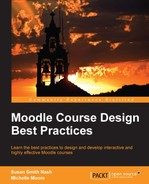So, you would like to build a great Moodle course? Or maybe improve the one you have? You've come to the right place. We want to help you take full advantage of all that Moodle has to offer, while creating more engaging and user-friendly experiences for your learners. At the same time, we want to make sure that you're not working harder than you need to be. We'll help you avoid doing things the hard way and focus your efforts so you're spending time where it will have the most impact.
Well-designed Moodle courses encompass much more than what happens in the course shell. The course design process begins with an optimally configured Moodle site and an understanding of the opportunities afforded by the Moodle platform.
In this chapter, we'll discuss:
- The advantages of Moodle from the perspective of a course designer
- Resources available to support you as you set up your Moodle site
- Site settings needed to implement the ideas presented later in the book
We'll start with the question, "Why Moodle?" What does it have to offer course designers, trainers, and educators? First and foremost, as educators ourselves, the fact that Moodle is built around an instructional ideal or educational philosophy makes it pretty exceptional. More specifically, Moodle's design is driven by a social constructionist pedagogy as inspired by educational theorists such as Vygotsky, Papert, and others. Social constructionism is a view of education that relies on the belief that people create knowledge through the process of constructing artifacts, including text, media, or other such projects, within a social environment. In short, this means that the creator of Moodle, Martin Dougiamas, built Moodle based on the idea that people learn best when they have an opportunity to construct, share, collaborate with, and learn from others. As we discuss Moodle's features, we'll see many ways in which this philosophy is exhibited.
Note
You can learn more about the pedagogy and philosophy behind Moodle in Moodle Docs, the Moodle Documentation wiki at http://docs.moodle.org/en/Pedagogy and http://docs.moodle.org/en/Philosophy.
Despite a strong pedagogical foundation, Moodle doesn't lock you into one way of teaching, which is another advantage of Moodle. It offers an array of choices when it comes to how you construct and deliver your course. In fact, we use this flexibility as the foundation for how this book is organized, with chapters devoted to a few of the more common ways that Moodle is used. Some are heavily reliant on social constructionist strategies, and others, less so. If you want to create a self-paced, content-driven course, Moodle can do that. If you need to facilitate a cohort-based, student-centered course, Moodle can do that too. Likewise, if you want to offer a very structured, linear course or, at the opposite end of the spectrum, manage a community, we think you'll find Moodle to be accommodating.
